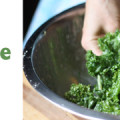
When you think of sea vegetables what comes to mind? Is it the stuff that makes sushi a nice and neat little package on your appetizer plate or maybe the seaweed sold as snacks for $1.00 a pop? How about the slimy-looking stuff that washes up on the beach along with broken sea shells and the occasional jellyfish or (God-forbid) fish hooks? Unlike the Japanese and other Asian countries that have enjoyed a variety of sea vegetables for centuries, Westerners are yet to fully appreciate the nutritional and taste potential of what the sea has to offer beyond fish.

Despite what we call them, sea vegetables are neither plant nor animals but classified in a group known as algae. From there they are further classified into categories by color (brown, green or red). Like soil-based plants, they still require sunlight but as long as the sun’s rays can penetrate the sea’s waters, algae can be found growing several feet below the water’s surface. They commonly grow on coral reefs or in rocky landscapes and can be found in marine salt water as well as fresh water lakes and seas. The names we typically hear (not surprisingly Japanese) are nori, hijiki, arame, kombu and dulse. You might also hear “kelp” thrown around but this is more or less a term to refer to any kind of sea vegetable (but it is also a scientific term used to name a particular type of brown algae).
There are three main reasons why it’s a good idea to incorporate some sea vegetables into your daily diet:
- Sea Vegetables have a high concentration of several essential minerals and may even be more available to our bodies for absorption than their soil-derived counterparts.
- With so much of our soil being over farmed, we have no choice to look to other potential mineral and vitamin sources.
- Sea Vegetables offer us new taste and texture opportunities to explore.
Minerals
Sea vegetables offer one of the broadest ranges of minerals of any food, containing virtually all the minerals found in the ocean (including many of the same minerals found in human blood). Not only are they an excellent source of iodine (which cannot be found at this concentration in any other food source) but they also considered to be a good source of calcium, copper, iron, magnesium, manganese, molybdenum, phosphorus, potassium, selenium, vanadium and zinc. They also contain a respectable amount of B vitamins (Folate, Riboflavin and Pantothenic Acid) as well as some vitamin C and E.
Sea Vegetable per .25 cup servings (or 20 grams)
Nutrient Amount Daily Value %
| Vitamin K | 13.2 mcg | 16.5 |
| Folate | 36.00 mcg | 9.0 |
| Magnesium | 24.20 mg | 6.0 |
| Calcium | 33.60 mg | 3.4 |
| Iron | .57 mg | 3.2 |
| Tryptophan | .01 g | 6.5 |
The Devastating Effects of Over Farming
The advantage of eating mineral rich sea vegetables verses those coming from soil has to do with the lack of quality farming techniques that ensures soil remains mineral-rich. As we know, minerals originate in soil and water. In soil, they can be depleted by intensive cultivation of a single crop year after year. In addition to this over-fertilizing can kill microorganisms needed to make the minerals present in soil soluble for crop uptake. It can also alter the chemical composition of the soil so that certain minerals become insoluble and cannot be taken up readily.
The Taste! The Texture! Oh My!!
Sea Veggies come in a variety of colors, shapes and textures. Some are best dried and used in place of salt at the dinner table while others can easily handle being the main feature at your next dinner party. Here you’ll find a list of some main types and potential uses for them (compliments of the Health Newsletter whose link can be found in the resource section).
|
Type of Sea Vegetable |
Cuisine Ideas |
Nutrients |
| Wakame(brown, mild flavor)
|
– Tastes delicious in soups and salads | -Good source of Omega-3s-High levels of calcium, iodine, thiamine and niacin. |
| Dulse(red, very salty taste and mildly spicy)
|
-Snack (you can buy dulse flakes and eat them right out of the package.-Soups and Salads(sprinkled on)-Pizza topping or sandwich filler | -Good source of protein, vitamins and minerals |
| Nori
(meaty, sweet flavor, most commonly wrapped around sushi and California rolls)
|
-Garnish-flavoring in noodle dishes, soups and vegetables-Quinoa salad
|
-Rich source of calcium, iron, iodine and vitamin A, B, C, E, and K.-Has the highest protein source of all edible marine plants-Good source of calcium and iron |
| Arame (also known as a type of kelp, has a mild, semi-sweet flavor and firm texture)
|
-Appetizers-Casseroles-Muffins
-Pilafs -Soups |
-Rich source of calcium, iodine, iron, magnesium and vitamin A.-Also contains cancer-fighting lignans. |
| Sea Lettuce (green, has a strong seafood taste)
|
-Soups-Salads | -High in protein-High in soluble fiber-Good source of iron |
Shopping Tips
- The best place to find sea vegetables are health food stores, Asian markets or from a reputable online source (you can find a few websites listed in the resource section).
- Seaweed supplements are also an option but again; make sure it’s a high quality product.
- When you have a choice, purchase a certified organic product.
- Be aware of the fact that you cannot be guaranteed a particular products nutrient levels based on environmental variables.
Yes, There’s Always A Downside…
Now that you know about all the wonderful qualities of sea vegetables, it’s only fair to tell you about their imperfections. As I mentioned already, sea vegetables have an excellent ability to take up minerals but this means they also possess the ability to take up heavy metals in polluted waters (including but limited to arsenic, lead and cadmium). Arsenic is the most problematic and in particular with hijiki, so although you might see this variety available for purchase, I would not do so unless it is certified organic. Another important point is that of the 20% of food borne diseases that occur annually, half of these are associated with algae but it’s not from ingesting pure algae so much as consuming oysters and clams that have eaten harmful algal blooms(or better known as “red tides”) in large quantities. For vegans, this is obviously not a problem!
Sea vegetables also cannot (currently) be seen as a sustainable and reliable staple in our food supply and it’s difficult to guarantee their mineral content because there are so many variables depending on weather conditions as well as water depth and source. The best that research can offer are mineral content ranges.

Now that we have looked at the up and down side of it all, I do hope you incorporate some sea vegetables into your daily diet. Try putting a shaker of dulse flakes out on the dinner table in place of salt or sprinkle some on top of your next noodle dish. Personally, my kids are crazy for seaweed snacks and I can even get them to take a few bites of seaweed salad but now that I’ve done this blog, I’m looking forward to experimenting even more!
by Melissa Sanborn of Nutritional Brands, PureVegan
Resources
- Sea Vegetable Websites: www.ImportFood.com, www.irishseaweeds.com
- Worlds Healthiest Foods: Sea Vegetables. http://www.whfoods.com
- Use Marine Plants and Be Among the Longest-Lived People on Earth/Health Newsletter. http://www.alsearsmd.com
- A Visual Guide to Sea Vegetables. http://www.marksdailyapple.com





1 Comment
Chia (324 comments)
October 31, 2012 at 4:04 pmI frequently prepare at-home meals with sea vegetable to add extra nutrition and taste. Some ideas I recommend:
– Sprinkle dulse flakes on top of rice or steamed veggies
– Add wakame to a soup broth
– Cook your beans together with a few strips of kombu
– Add a spoonful of ground kombu to a soup as it’s cooking
– Snack on toasted nori sheets